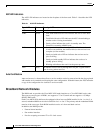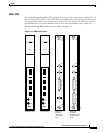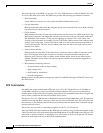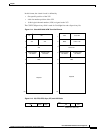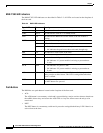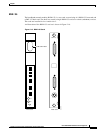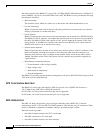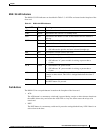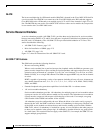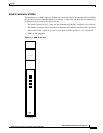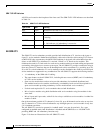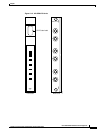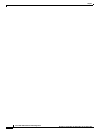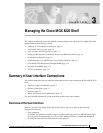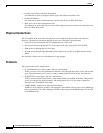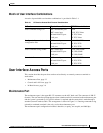
2-22
Cisco MGX 8220 Installation and Configuration
Release 5.0, Part Number 78-6430-03 Rev. D0, November 2003
Chapter
Core Module Overview
IMATM
The inverse multiplexing for ATM trunk module (IMATM) is housed in the Cisco MGX 8220 shelf in
a service module slot. IMATM is an extension to the Cisco BPX 8600 series BNI card that supports
Cisco BPX 8600 series ATM trunks over multiple (up to 8) T1 and E1 lines instead of single T3 or E3
line. The IMATM does not use the Cisco MGX 8220 cell bus as other service modules do, but provides
its own trunk to the Cisco BPX 8600 series.
Service Resource Modules
A service redundancy module (AX-SRM-T1/E1) provides three major functions for service modules:
bit error rate testing (BERT) of T1 and E1 lines and ports, loop back of individual nx64 channels toward
the CPE, and 1:N redundancy. The AX-SRM-3T3 also provides bulk distribution of T1 lines. This
section described the following:
• AX-SRM-T1/E1 Features, page 2-22
• Rules for Installation of SRMs, page 2-23
• AX-SRM-3T3, page 2-24
Figure 2-17 shows an illustration of the AX-SRM-T1/E1 card.
AX-SRM-T1/E1 Features
The SRM cards provide the following functions:
• Bit error rate testing (BERT)
When a service module line or port has been put into loopback mode, the SRM can generate a test
pattern over the looped line or port, read the received looped data, and report on the error rate. This
operation can be performed on a complete T1 or E1 line, on a fractional T1 or E1 line, on a DS0
bundle (NxDS0), or on a single DS0 channel. The SRM can support BERT only one line or channel
at a time.
BERT is capable of generating a variety of test patterns including all ones, all zeros, alternate one
zero, double alternate one zero, 2
23
-1, 2
20
-1, 2
15
-1, 2
11
-1, 2
9
-1, 1 in 8, 1 in 24, DDS1, DDS2, DDS3,
DDS4, and DDS5.
• Extended loopback code-generation capabilities for individual DS-1 or subrate streams
• 1:N service module redundancy
Service module redundancy provides 1:N redundancy for multiple groups of service modules where
a group can consist of N active and one standby service modules. The redundant service module in
a group must be a superset (with respect to functionality) of the cards. For example, one group
could contain all the FRSMs and another all the AUSMs.
1:N redundancy must be configured by the user. When the failure of an active card in a group is
detected by the ASC, the SRM is ordered to invoke 1:N redundancy for that group. The back card
of the failed service module now directs data to and from the standby service module. With the
SRM-T1/E1, when 1:N redundancy is invoked for a group, it is not available to the other groups or
to other service modules in the group using 1:N redundancy. Another failure in any group results
in a shelf alarm. This restriction does not apply to the SRM-3T3, for example, the SRM-3T3 can
support multiple group failures.



